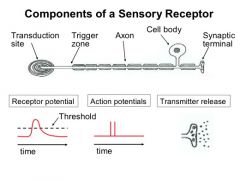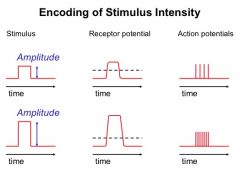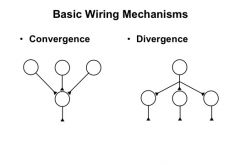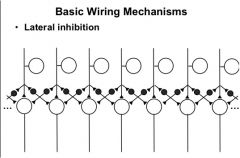![]()
![]()
![]()
Use LEFT and RIGHT arrow keys to navigate between flashcards;
Use UP and DOWN arrow keys to flip the card;
H to show hint;
A reads text to speech;
15 Cards in this Set
- Front
- Back
|
Sensory receptors and systems:
• Name the basic sensory receptor classes and their general stimuli (4) • Name the basic sensory systems (6) • Associate the receptor classes to the sensory systems |
Sensory receptors and systems:
• The basic sensory receptors - Mechanoreceptors, mechanical stimulation - Thermoreceptors, temperature - Chemoreceptors, chemical substances - Photoreceptors, light • Basic sensory systems and their associated receptors: - Auditory, Mechanoreceptors - Gustatory, Chemoreceptors - Olfactory, Chemoreceptors - Vestibular, Mechanoreceptors - Visual, Photoreceptors - Somatosensory, (Chemo-, Mechano-, and Thermo-) receptors |
|
|
General components of a sensory receptor
|

Perikaryon
The transduction site - where the signal is translated into cellular activity The axon The synaptic terminal - where the signal is transmitted |
|
|
Three basic processes that occur in different parts of the sensory receptor
|
Receptor potential
Action Potential Transmitter release |
|
|
Receptor Potential:
• The part of the receptor where they are generated • are these types of potentials, displaying variability in these two characteristics • Do not follow this rule of APs |
Receptor Potentials:
• are generated at the transduction site • are graded potentials, displaying variability in duration and intensity • Do NOT follow the All-or-None rule |
|
|
Action Potentials:
• The part of the receptor where they are generated • The directionality of AP conduction down the axon (use proximal/distal to describe) |
Action Potentials:
• The Trigger Zone of the axon • From the distal part of the axon to the proximal part |
|
|
Transmitter Release:
• The part of the receptor where it takes place • After release into this area, the transmitter binds to this type of a neuron (two names) |
Transmitter Release:
• Synaptic terminal • After release into the synaptic cleft, the transmitter binds to receptors on the post-synaptic cell, or a 2nd order neuron of the sensory pathway |
|
|
Four characterizations of a sensory stimulus
|
• Modality (type or quality)
• Intensity (amplitude or quantity) • Duration (time btwn the start & end of a stimulus) • Location (where it is located or originated) |
|
|
Explain how modality is encoded in the sensory system and the name of the code that describes it
|
Modality refers to the type or quality of stimulus energy.
However irrespective of the modality, the difference between how the 6 sensory systems fxn in response to a stimulus does not depend on the modality of the stimulus itself, but the nerve structures the stimulus excites and the location to which the signals are sent. This is called the "Label line code." |
|
|
Encoding of stimulus intensity:
• Where it starts • The two codes of intensity - the number of neurons to which it applies - the main idea behind each |

Encoding of stimulus intensity:
• Signal transduction site • Two codes of stimulus intensity - Frequency code > applies to individual neurons and their axons > The main idea is higher intensity stimuli generate higher receptor APs, leading to more numbers of APs/unit time - Population Code > applies to many neurons and axons at a time > The main idea is high intensity stimuli will activate more individual axons |
|
|
Encoding of a stimulus duration:
• Where it starts • Explain "receptor adaptation" • Two types of receptors involved - their relationship of depolarization and APs - an example of when they are important |
Encoding of a stimulus duration:
• Starts at the level of a receptor • The process of the sensation induced by a stimulus disappears, until it is no longer recognized; ex. touch of clothes during the day • Two types receptors involved - Slow adapting > these receptors remain depolarized and produced increased rates of APs for the whole duration of the stimulus > Important for regulatory fxns such as when a parameter or set point has to be kept at a value - Rapidly adapting receptors: >May only depolarize at the onset of a stimulus with the receptor potential returning to baseline. No further APs are generated despite the stimulus still at the same intensity > they would be more sensitive to changes than constant stimulation |
|
|
Differences btw graded potentials and APs (3)
|
1) APs are all-or-none while graded potentials can vary with amplitude
2) APs are much faster than graded potentials 3) APs have shorter durations than graded potentials |
|
|
Encoding of stimulus location:
• Define the receptive field of a neuron |
It is the area where responses can be induced for a given neuron
|
|
|
The three basic wiring systems of neurons
|
Convergence, divergence and lateral inhibition
|
|
|
Differentiate btwn Convergence and Divergence wiring mechanisms and the fxnal consequence of each
(Explain answers in terms of 1st and 2nd order neurons) |

Convergence Wiring Mechanism:
A 2nd order neuron receives input from +1> 1st order neuron. Consequence - the wiring helps resolve where the input came from Diverging Wiring System: A 1st order neuron sends a signal +1> 2nd order neurons. Consequence - The wiring helps resolve where the input is going |
|
|
Lateral inhibition:
• Definition • Types of neurons involved and the general scheme • Types of connections and designated point system • The idea behind lateral inhibition and the point system |

Lateral inhibition:
• The capacity of an excited neuron to reduce the activity of its neighbors • General scheme: - 1st order neurons are sending excitatory input/connected to interneurons and 2nd order neurons - Interneurons are sending inhibitory input to 2nd order neurons • Type of connections and point value: Excitatory connections receive a +3x value Inhibitory connections receive -1x value • The concept helps determine the effect of lateral inhibition for a stimulus against its background |

